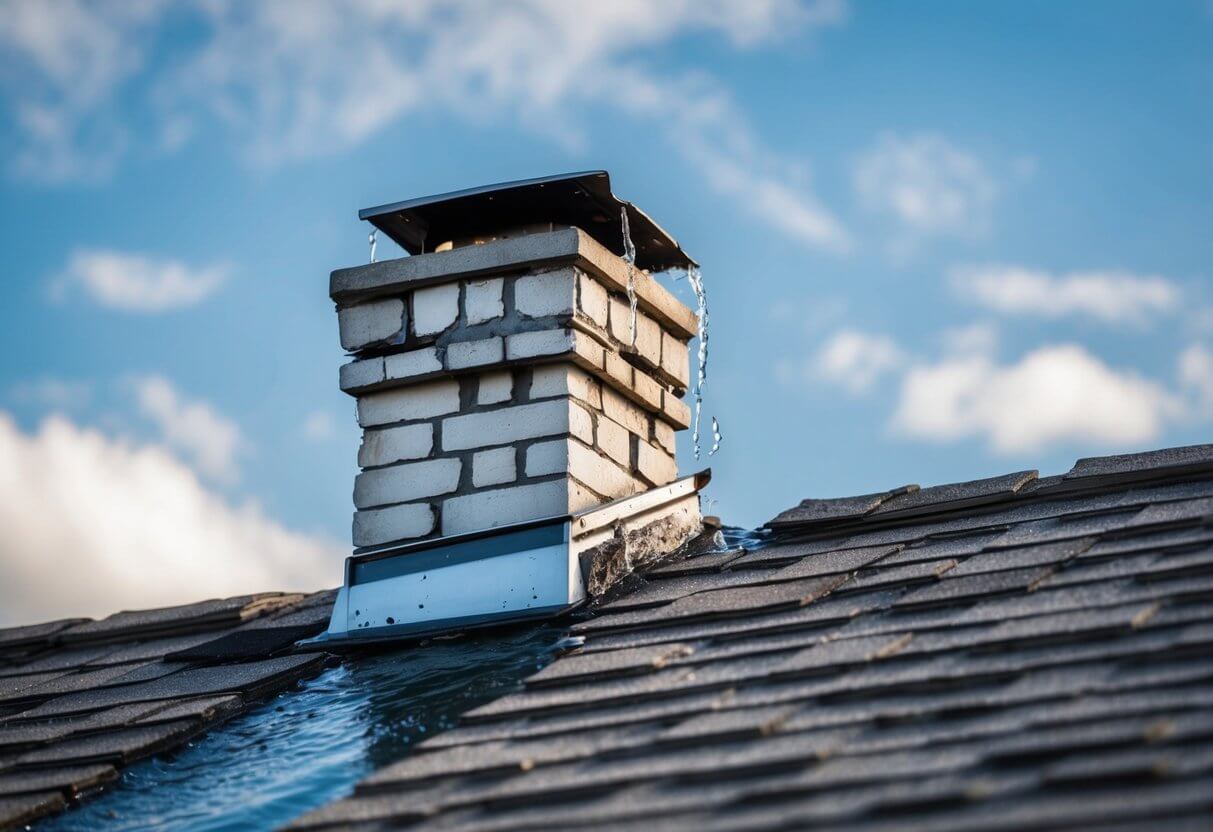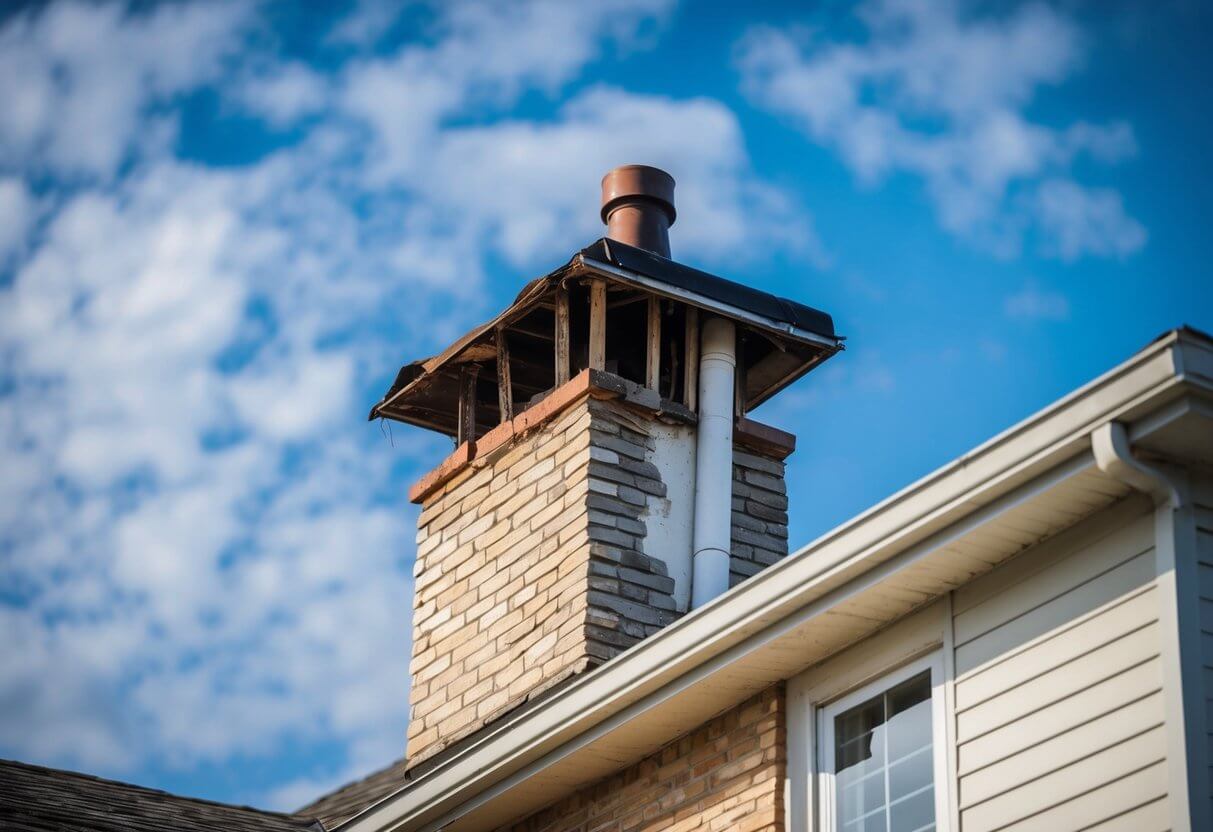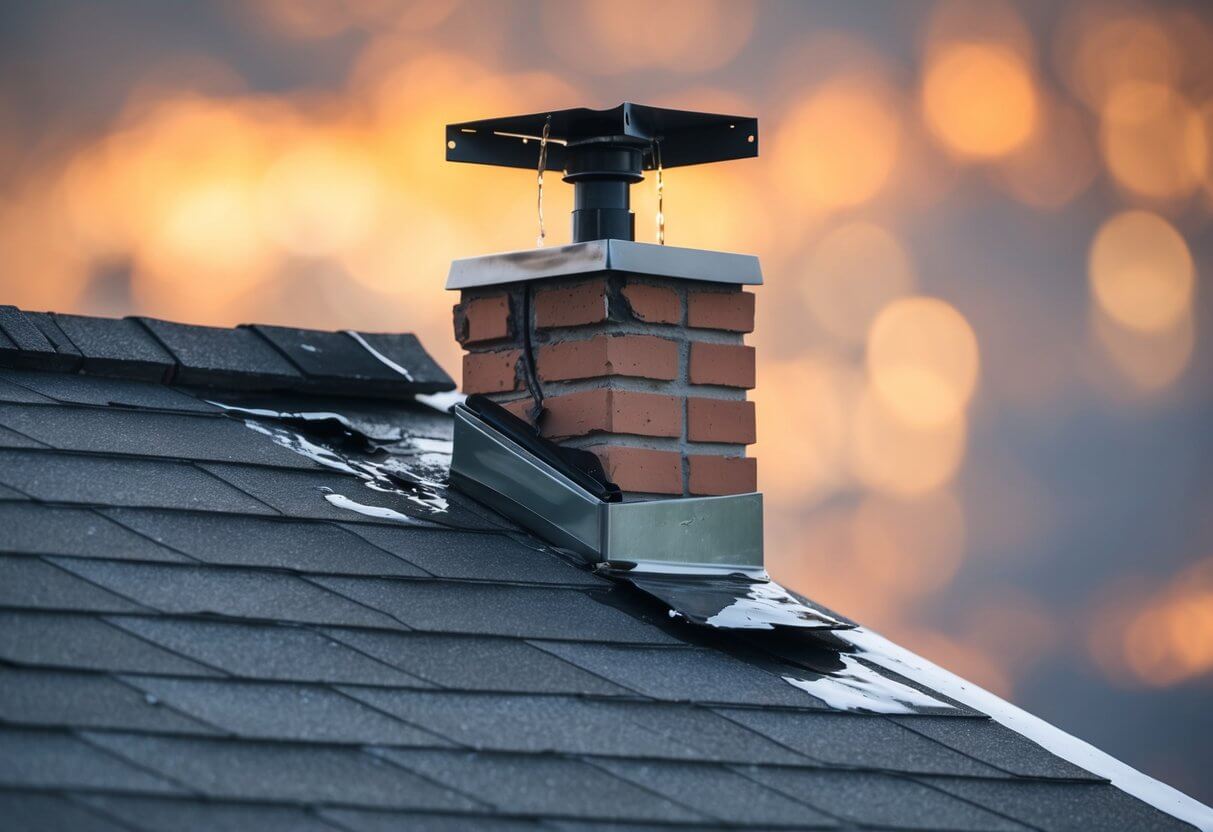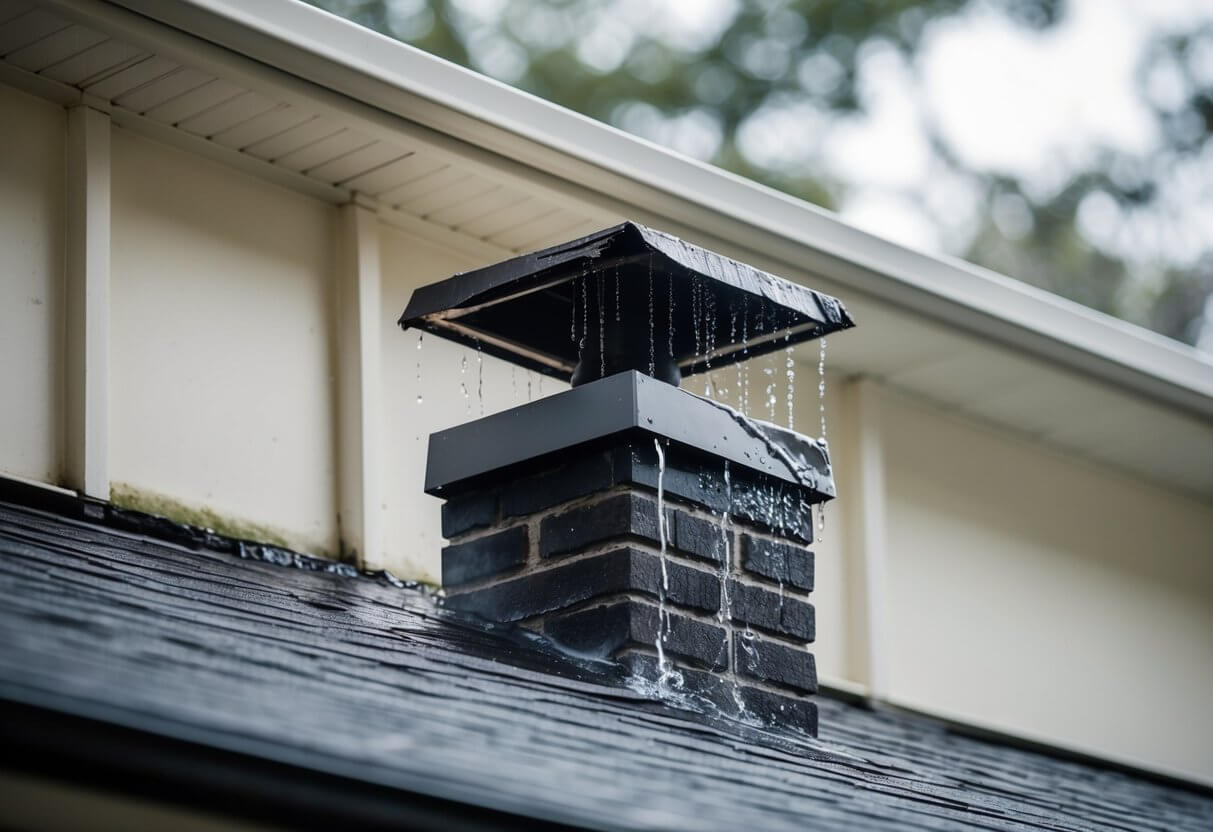The Hidden Dangers of Neglected Chimney Flashing: Safeguarding Your Home from Water Damage

The Hidden Dangers of Neglected Chimney Flashing: Safeguarding Your Home from Water Damage
Chimney flashing plays a crucial role in protecting your home from water damage. This often-overlooked component acts as a barrier between your roof and chimney, preventing moisture infiltration. Neglected chimney flashing can lead to extensive water damage, including rotting wood, mold growth, and expensive repairs to both the roof and interior of your home.
Proper installation and maintenance of chimney flashing are essential for safeguarding your property. Chimney flashing serves as an indispensable shield, meticulously crafted to fortify the intersection between your roof and chimney. It effectively repels rainwater and thwarts its attempts to permeate your home’s interior.
Regular inspection and timely repairs of chimney flashing can save homeowners significant time, money, and stress in the long run. By addressing issues early, you can prevent water from infiltrating your home and causing costly damage. Keeping an eye on your chimney flashing and tackling issues early is a proactive approach to home maintenance that pays dividends in the form of a dry, structurally sound living space.
Key Takeaways
- Chimney flashing prevents water damage by sealing the roof-chimney intersection.
- Regular inspection and maintenance of flashing are crucial for home protection.
- Prompt repair of damaged flashing can prevent costly structural issues.
Understanding Chimney Flashing
Chimney flashing is a critical component that protects homes from water damage. It creates a watertight seal between the chimney and roof, preventing moisture intrusion.
The Role of Chimney Flashing
Chimney flashing serves as a vital shield against water infiltration. It directs rainwater and melting snow away from the intersection of the chimney and roof.
Properly installed flashing prevents leaks that can lead to structural damage, mold growth, and expensive repairs. It also helps maintain the integrity of the chimney structure.
Flashing typically consists of two main parts:
- Base flashing: Installed on the roof surface
- Counter flashing: Applied to the chimney itself
This two-part system ensures comprehensive protection against water intrusion from various angles and weather conditions.
Common Materials and Types
Chimney flashing is available in several durable materials:
- Aluminum: Lightweight and corrosion-resistant
- Copper: Long-lasting and develops an attractive patina
- Galvanized steel: Strong and cost-effective
- Lead: Malleable and excellent for custom fitting
Step flashing is a common technique used for chimneys. It involves installing overlapping pieces of flashing material in a step-like pattern up the sides of the chimney.
For wider chimneys, saddle flashing may be employed. This creates a peaked structure that efficiently diverts water away from the chimney-roof intersection.
Warning Signs of Chimney Flashing Failure
Detecting chimney flashing issues early can prevent extensive water damage to your home. Homeowners should be vigilant for visual defects and signs of water infiltration around the chimney area.
Visual Inspection for Defects
Regular visual inspections of chimney flashing can reveal potential problems. Look for visible cracks or gaps in the flashing material. These openings allow water to penetrate the roof structure.
Check for missing sections of flashing or areas where it has pulled away from the chimney. Rust or corrosion on metal flashing indicates deterioration and reduced effectiveness.
Examine the mortar joints between the chimney and flashing. Crumbling or eroded mortar compromises the seal. Inspect for any warping or buckling in the flashing material, which can create openings for water entry.
Indicators of Water Infiltration
Water stains on ceilings or walls near the chimney are clear signs of flashing failure. These discolorations often appear as brownish spots or rings.
Peeling paint or wallpaper around the chimney area suggests moisture intrusion. Mold growth on interior surfaces near the chimney is another red flag of persistent dampness.
Check the attic for signs of water damage. Look for wet insulation, water stains on rafters, or rotting wood. A musty odor in the attic can indicate hidden moisture problems.
During rainstorms, listen for dripping sounds coming from the chimney area. This can point to active leaks that require immediate attention.
Maintenance and Prevention Strategies
Proper maintenance and prevention are crucial for protecting your home from water damage caused by faulty chimney flashing. Regular upkeep and timely repairs can save homeowners significant costs and headaches in the long run.
Regular Inspections and Cleaning
Homeowners should schedule annual chimney inspections with certified professionals. These experts can identify early signs of flashing deterioration or damage.
During inspections, technicians thoroughly examine the flashing, masonry, and surrounding roofing materials. They look for gaps, cracks, or loose sections that could allow water infiltration.
Cleaning is an essential part of maintenance. Debris accumulation around the chimney can trap moisture and accelerate flashing deterioration. Removing leaves, twigs, and other debris helps prevent water pooling.
Homeowners can perform visual checks between professional inspections. They should look for obvious signs of damage or wear, such as rust spots or separated flashing.
Proactive Repairs and Waterproofing
When issues are identified, prompt action is necessary. Small problems can quickly escalate if left unattended.
Professional chimney repair services can address flashing issues effectively. They may reattach loose flashing, replace damaged sections, or apply new sealant as needed.
Waterproofing is a key prevention strategy. Applying a waterproof seal to the chimney masonry can provide an extra layer of protection against moisture penetration.
For complex repairs, homeowners should consult roofing experts. They can ensure proper integration of the flashing with the roof system.
Regular maintenance of gutters and downspouts is also important. Proper water drainage away from the chimney area reduces the risk of water damage to the flashing and surrounding structures.
Professional Repair Solutions
Expert chimney services offer reliable solutions for flashing issues. Professional technicians have the skills and tools to properly diagnose and fix chimney flashing problems, ensuring long-lasting protection for your home.
Choosing the Right Chimney Service Provider
When selecting a chimney service provider, look for licensed and insured professionals with specific experience in flashing repair. Check customer reviews and ask for references to gauge their reputation and quality of work.
Ensure the company offers comprehensive inspections before starting any repairs. This helps identify the full extent of the damage and prevents overlooked issues.
Ask about warranties on both materials and labor. Reputable companies often provide guarantees on their work, giving homeowners peace of mind.
The Process of Professional Chimney Flashing Repair
Professional chimney flashing repair begins with a thorough inspection of the chimney, roof, and surrounding areas. Technicians assess the extent of damage and determine the best repair approach.
The repair process typically involves:
- Removing damaged flashing
- Cleaning and preparing the area
- Installing new, high-quality flashing materials
- Sealing joints and edges to prevent water infiltration
Chimney flashing repair may include replacing step flashing, counter flashing, or both depending on the damage. Professionals use specialized tools and techniques to ensure a proper fit and seal.
In cases of severe damage, experts might recommend complete replacement of the flashing system. This ensures optimal protection against water intrusion and extends the lifespan of your chimney and roof.
DIY Chimney Flashing Repair
Repairing chimney flashing can be an achievable DIY project for homeowners with basic tools and skills. Proper preparation and careful execution are key to creating an effective waterproof barrier.
Safety Precautions and Preparation
Safety should be the top priority when working on a roof. Wear sturdy shoes with good traction and use a safety harness if possible. Choose a dry, calm day for the repair work.
Gather necessary tools and materials before starting: metal flashing, roofing cement, caulk, screws, and a wire brush. Clean protective eyewear and work gloves are essential safety gear.
Inspect the roof area around the chimney carefully. Look for signs of water damage, loose flashing, or deteriorated sealant. Identifying all problem areas beforehand ensures a comprehensive repair.
Step-by-Step Guide to DIY Repair
Begin by cleaning the area thoroughly. Use a wire brush to remove dirt, rust, and old sealant. A clean surface is crucial for proper adhesion of new materials.
Remove damaged flashing carefully to avoid damaging the roof or chimney. Cut new flashing to size, ensuring it overlaps correctly to create a waterproof barrier.
Apply a layer of roofing cement where the new flashing will be placed. Position the flashing and secure it with screws. Cover screw heads with additional roofing cement.
Seal edges with high-quality exterior caulk for added waterproofing. Some homeowners opt to use flashing tape for extra protection in vulnerable areas.
Test the repair by spraying water around the chimney and checking for leaks from inside the attic. Address any issues immediately to prevent future water damage.
Frequently Asked Questions
Proper chimney flashing maintenance is crucial for preventing water damage and structural issues in homes. Homeowners should be aware of key signs, materials, and professional services related to chimney flashing care.
What steps are necessary to properly maintain chimney flashing?
Regular cleaning and inspection of the flashing are essential. Remove debris and check for loose or damaged areas. Apply a sealant to minor cracks or gaps. For larger issues, consult a professional roofer or chimney specialist.
Ensure proper drainage around the chimney area. Trim overhanging branches that could damage the flashing or trap moisture.
Can improper chimney flashing lead to structural damage in a home?
Yes, improper chimney flashing can cause significant structural damage. Water infiltration can rot wooden structures, weaken masonry, and compromise the roof’s integrity.
Persistent leaks may lead to mold growth, affecting indoor air quality and potentially causing health issues. Addressing flashing problems promptly is crucial to prevent extensive and costly repairs.
What materials are best for sealing chimney flashing?
High-quality silicone or polyurethane sealants are effective for minor repairs. For more substantial work, copper or lead flashing materials offer durability and weather resistance.
Avoid using cheap caulk or tar-based products, as these degrade quickly under harsh weather conditions. Professional-grade flashing cement can provide a robust, long-lasting seal when applied correctly.
What are signs of failing chimney flashing that homeowners should be aware of?
Water stains on ceilings or walls near the chimney are clear indicators of flashing issues. Peeling paint or wallpaper in these areas may also signal water infiltration.
Rust on the chimney cap or flashing components indicates moisture problems. Cracked or missing mortar between bricks can be a sign of water damage due to failing flashing.
How often should chimney flashing be inspected for potential issues?
Annual inspections are recommended for chimney flashing. Homeowners should also check after severe weather events or if they notice any signs of leaks.
Professional chimney sweeps often include flashing inspection as part of their regular maintenance services. This frequency allows for early detection of potential problems.
What professional services are recommended for repairing damaged chimney flashing?
Licensed roofing contractors with experience in chimney work are ideal for flashing repairs. They can assess the extent of damage and perform necessary repairs or replacements.
Certified chimney specialists may also offer flashing repair services. These professionals understand the unique challenges of chimney structures and can ensure proper installation and sealing.







Can you be more specific about the content of your article? After reading it, I still have some doubts. Hope you can help me.
I don’t think the title of your article matches the content lol. Just kidding, mainly because I had some doubts after reading the article.
Tui mới vào chơi xèng là gì test thử thì vừa quay vừa run vì căng thẳng hơn cả đá banh 😂
Thanks for sharing. I read many of your blog posts, cool, your blog is very good.
Your point of view caught my eye and was very interesting. Thanks. I have a question for you.
Your point of view caught my eye and was very interesting. Thanks. I have a question for you.
**mindvault**
mindvault is a premium cognitive support formula created for adults 45+. It’s thoughtfully designed to help maintain clear thinking
**mindvault**
mindvault is a premium cognitive support formula created for adults 45+. It’s thoughtfully designed to help maintain clear thinking
**prostadine**
prostadine is a next-generation prostate support formula designed to help maintain, restore, and enhance optimal male prostate performance.
**sugarmute**
sugarmute is a science-guided nutritional supplement created to help maintain balanced blood sugar while supporting steady energy and mental clarity.
**gl pro**
gl pro is a natural dietary supplement designed to promote balanced blood sugar levels and curb sugar cravings.
**mitolyn**
mitolyn a nature-inspired supplement crafted to elevate metabolic activity and support sustainable weight management.
**zencortex**
zencortex contains only the natural ingredients that are effective in supporting incredible hearing naturally.
**prodentim**
prodentim an advanced probiotic formulation designed to support exceptional oral hygiene while fortifying teeth and gums.
**vitta burn**
vitta burn is a liquid dietary supplement formulated to support healthy weight reduction by increasing metabolic rate, reducing hunger, and promoting fat loss.
**yusleep**
yusleep is a gentle, nano-enhanced nightly blend designed to help you drift off quickly, stay asleep longer, and wake feeling clear.
**synaptigen**
synaptigen is a next-generation brain support supplement that blends natural nootropics, adaptogens
**nitric boost**
nitric boost is a dietary formula crafted to enhance vitality and promote overall well-being.
**glucore**
glucore is a nutritional supplement that is given to patients daily to assist in maintaining healthy blood sugar and metabolic rates.
**wildgut**
wildgutis a precision-crafted nutritional blend designed to nurture your dog’s digestive tract.
**pinealxt**
pinealxt is a revolutionary supplement that promotes proper pineal gland function and energy levels to support healthy body function.
**energeia**
energeia is the first and only recipe that targets the root cause of stubborn belly fat and Deadly visceral fat.
**boostaro**
boostaro is a specially crafted dietary supplement for men who want to elevate their overall health and vitality.
**prostabliss**
prostabliss is a carefully developed dietary formula aimed at nurturing prostate vitality and improving urinary comfort.
**breathe**
breathe is a plant-powered tincture crafted to promote lung performance and enhance your breathing quality.
**potentstream**
potentstream is engineered to promote prostate well-being by counteracting the residue that can build up from hard-water minerals within the urinary tract.
**hepato burn**
hepato burn is a premium nutritional formula designed to enhance liver function, boost metabolism, and support natural fat breakdown.
**hepatoburn**
hepatoburn is a potent, plant-based formula created to promote optimal liver performance and naturally stimulate fat-burning mechanisms.
**cellufend**
cellufend is a natural supplement developed to support balanced blood sugar levels through a blend of botanical extracts and essential nutrients.
**prodentim**
prodentim is a forward-thinking oral wellness blend crafted to nurture and maintain a balanced mouth microbiome.
**flow force max**
flow force max delivers a forward-thinking, plant-focused way to support prostate health—while also helping maintain everyday energy, libido, and overall vitality.
**revitag**
revitag is a daily skin-support formula created to promote a healthy complexion and visibly diminish the appearance of skin tags.
**neuro genica**
neuro genica is a dietary supplement formulated to support nerve health and ease discomfort associated with neuropathy.
**sleep lean**
sleeplean is a US-trusted, naturally focused nighttime support formula that helps your body burn fat while you rest.
**memory lift**
memory lift is an innovative dietary formula designed to naturally nurture brain wellness and sharpen cognitive performance.
https://shorturl.fm/q65If
Thanks for sharing. I read many of your blog posts, cool, your blog is very good.
Roulette’s my game! So I hit up casinorouletteonline. Honestly? Solid! Easy to navigate, decent graphics. Spinnin’ those wheels like a boss! Definitely worth a look if you’re a roulette fan. Check out casinorouletteonline.
Alright, 6ffgame! Another new one to try. Hopefully, the gameplay is solid. Let’s get this game on! 6ffgame
77betdownload. Downloading the app was easy enough. Didn’t have any weird issues. Check it out yourself: 77betdownload
Vaobong88viva88… Now that’s a mouthful! Heard they got all the sports betting stuff. Odds seem competitive. Might toss a bet on the game tonight. Take a look: vaobong88viva88
https://shorturl.fm/lNZUt